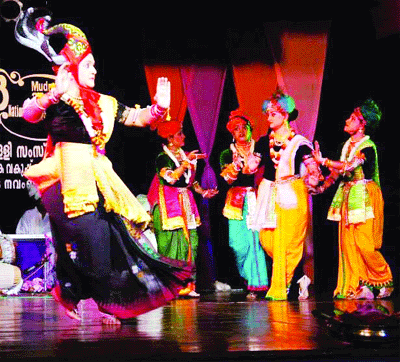Danseuse Sruti Bandyopadhyay has mixed many styles of Manipuri dance to depict the episodes of lord Krishna’s life. She shares with Utpal K Banerjee that her guru borrowed ideas from different North Eastern traditions for his choreography
In the beleaguered land of Manipur today, it is difficult to imagine that — tucked away in the country’s furthest North East and ensconced by a garland of hills — the state’s geographical isolation could lead to the carving of a most distinct and unique cultural identity. Indeed, over centuries, its people have so avidly preserved and nurtured their artistic tradition that one rarely comes across any Manipuri (called Meitei) who does not know dance and music. The Indo-Mongoloid race (of which they are descendants), by nature, is very artistic, deeply emotional and passionate. This disposition is reflected in their myriad art forms.
Dancing to please and worshipping the ancient deities — who created their land — came through their oldest festival of lai Haraoba. later, from the 18th century after the advent of Vaishnavism, the instinctive penchant and vision of the people to use dance and music as a medium to venerate the gods, gained momentum. Some of the dances and dance dramas that evolved after the emergence of Vaishnava cult are the various Raas leela’s — traditional dance drama revolving around the divine love of lord Krishna and Radha. Udukhal raas was a traditional dance drama based on the childhood pranks of young Krishna. Goshtha leela narrated the valorous deeds of young Krishna when he goes out to the meadows to tame the cattle.
The Manipuri dance recital, recently presented under the ICCR by the noted scholar-dancer, Sruti Bandyopadhyay with her troupe from Kolkata and Visva Bharati, brought out the one dance form where the dancers wore no anklets, for their subtle aesthetics did not accent the contact of rhythmic foot-beats. Instead, there was a continual movement-flow — with understated rhythm-in-the-air. Faces were uniformly serene — with no austere expression and the arms limited their ambits of movement — keeping them confined in space close to the body.
Sruti began with Sakhya prem, highlighting camaraderie among the child Krishna’s companions, inspired by Udukhal raas. The little pranksters, affectionately watched by Yashoda, had their hearts’ fill with stolen butter and were doted upon — instead of being admonished — by the mother-figure, as an unexpected reward. In Goshtha leela that followed, cowherd friends came to plead with Yashoda to let the brother duo, Krishna and Balarama, to join them on the meadows for grazing the cows.
A visibly reluctant mother initially resisted but was persuaded later to allow them all to go together. The pasture-game of ball-throw led to the vicinity of Vasuki snake in the Kalindi lake and Krishna’s brave fight with an ominous monster. In the second part, Raas leela led to a really colourful Vasanta raas as the spring dalliance. The milk-maids were clad in resplendent circular skirts and facial veils, enjoying thoroughly their sprinkling of colours on Krishna and throwing flower petals.
Having been groomed by the celebrated master Bipin Singh of Kolkata, Sruti — with her disciples — made it evident how her famous guru had borrowed ideas from different Manipuri traditions to enrich his items and had replicated multiple rhythmic patterns. Apart from the unusual tala divisions, there were tandava movements of Krishna, not common among dances of other Manipuri gurus. On being asked, Sruti readily conceded the point, adding, “I have mixed many styles prevalent among the Manipuri genres. The result in aesthetic excellence is there for all to see.”


























